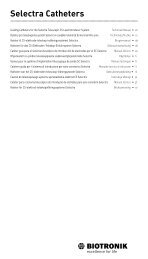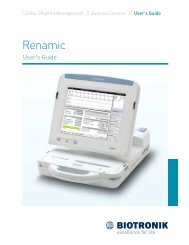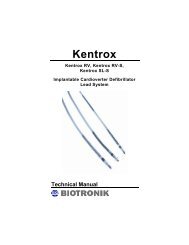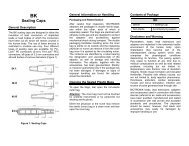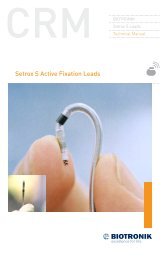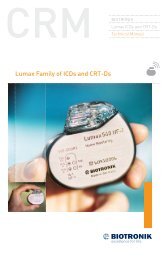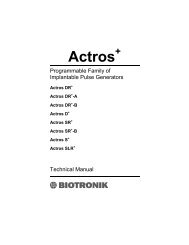Estella Pulse Generators - BIOTRONIK USA - News
Estella Pulse Generators - BIOTRONIK USA - News
Estella Pulse Generators - BIOTRONIK USA - News
Create successful ePaper yourself
Turn your PDF publications into a flip-book with our unique Google optimized e-Paper software.
48 <strong>Estella</strong> <strong>Pulse</strong> <strong>Generators</strong> Technical Manual7.2.1 Basic RateThe basic rate is the pacing rate in the absence of a spontaneous rhythmand is programmable up to 200 ppm.CautionProgramming Modifications—Extreme programming changesshould only be made after careful clinical assessment. Clinicaljudgment should be used when programming permanent pacingrates below 40 ppm or above 100 ppm.7.2.2 Rate HysteresisHysteresis can be programmed OFF or to values as low as ‐5 bpm andas high as -90 bpm. The Hysteresis rate is based on the lower rate andthe value of the programmable parameter. Hysteresis is initiated by asensed event. The resulting Hysteresis rate is always less than the lowerrate. A conflict symbol will appear and transmission will be prohibitedfor Hysteresis rates which are less than 30 bpm. The ability to decreasethe effective lower rate through Hysteresis is intended to preserve aspontaneous rhythm. The pulse generator operates by waiting for asensed event throughout the effective lower rate interval (Hysteresisinterval). If no sensed event occurs, a pacing pulse is emitted followingthe Hysteresis interval.NOTE:If rate adaptation is active, the Hysteresis rate is based on thecurrent sensor-indicated rate and the value of the programmableparameter.Hysteresis is not available in DVI, and DVIR modes.If Hysteresis is used in the DDI mode, the AV delay must beprogrammed shorter than the spontaneous AV conduction time.Otherwise, stimulation in the absence of spontaneous activity occursat the hysteresis rate instead of the lower rate.During night mode the rate will not fall below the programmed nightrate even if Hysteresis can take it to a lower rate. Programmingconflicts arise when the total decrease in rate is below 30 ppm. Careshould be exercised to avoid programming a Night Mode rate andhysteresis that is below what is appropriate and may be tolerated bythe individual patient.



